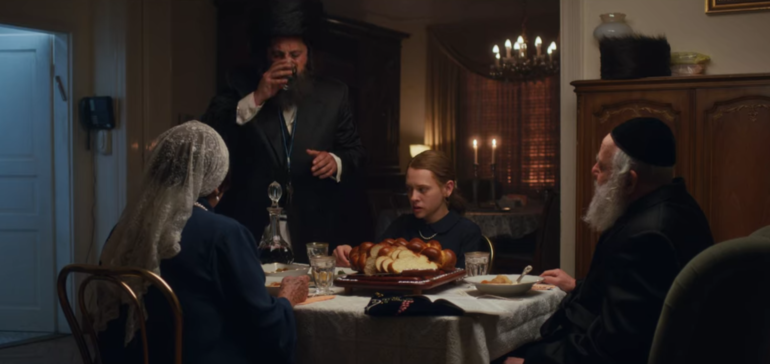
“Unorthodox” Tells Some People’s Ex-Hasidic Story, And Not Others
They say that beauty is in the eye of the beholder, and I believe that trauma is too. Human beings often have a hard time understanding where other people are coming from, especially if they went through similar experiences and but came out feeling differently. This was definitely the case when I started Jew in the City; I was confronted by people who had lived through the worst the Orthodox world has to offer. I didn’t understand them and they didn’t understand me.
Since launching Makom several years ago, I have had a chance to hear hundreds of stories from people raised in dysfunctional situations in the Orthodox Jewish world, where parts of their abuse were seamlessly woven into their religious experience. This broadened my eyes as to how a beautiful way of life can be perverted into something sick. As one of our members told me, “I don’t know the difference between Judaism and dysfunction.”
It made me realize that our original mission of showing positive Orthodox Judaism to non-Orthodox Jews needed to be extended to some of the people who were raised Orthodox. And that’s not because everyone has to be religious. I believe we were all given free-will and are meant to exercise it as we see fit. At the same time, I believe that people must know what’s out there, so they can make informed choices. (Learning about Jewish observance and Torah wisdom was the best choice I ever made once I had my chance to learn about them.)
So what’s my take on Netflix’s new miniseries, “Unorthodox?” Lots of people have been asking me this question since it debuted last week.
How should I know? I have never lived in a society like this. And I have never tried leaving a society like this. Though, I will add that even so, the rate and ease with which the protagonist left her Hasidic community would be comical if not for the fact that it is so hurtful. I have spoken to OTD members of Makom who explained that the way the series covered her leaving was painful to watch because it was so unrealistic compared to what they were dealing with.
“Unorthodox” is not anything like the Orthodox world that I live in nor is it anything like the Orthodox world that my happy Hasidic friends live in, but I understand that other people have experienced things differently than I have.
So instead of opining on how accurate or realistic it is, I’m sitting on the sidelines watching ex-Hasidim hash this out. I shared this article by ex-Hasidic writer, Frieda Vizel, on our Makom WhatsApp chat today, which very much resonated with me. It led to a lot of strong opinions. Some members said that Frieda’s take was spot on. Others said she was way off and “Unorthodox” was spot on.
I used to think of ex-Hasidim as breaking into two groups: those who left observance completely and those, like the people who come to Makom, and are trying to make amends with Orthodox Judaism. Seeing this reaction today made me realize that not all people who chose to leave will look back at their community of origin the same way. Some may have never been as hurt to begin with, so they can’t relate to a depiction that is so extreme and severe. Others may have gotten hurt, but got to a point in their healing where they can see the place they come from with more understanding and compassion (even if they vehemently disagree with it), yet for others, their perspective will remain unchanged no matter where life takes them.
I think we need to allow room for all of these experiences to exist without trying to invalidate them. It’s crazy, I know.
What are my other takeaways? We need to work with insiders in these communities to let them know the experiences that are pushing people away. If one member tells me “My wedding night was not like that,” and another tells me theirs was, we need to figure out systematic ways to make sure the least amount of people suffer from bad information being given over in the name of Torah.
“But every community has dysfunction!” some might argue. That is true, but this is our dysfunction, and what a mitzvah it would be to heal it.
I also wish there was a way for viewers to understand that what they see in “Unorthodox” and most other depictions of Hasidim in popular media, does not reflect the entirety of the experience of those who stay or those who leave. Because over-generalizing and believing that some people’s experiences are everyone’s experiences will prevent Jews from knowing all the good that could exist in a an observant Jewish life (be they totally secular or traumatized religious Jews).
As I noted last year, a Reform friend from high school, who watched me become religious and knows my present-day life, could not differentiate between it and what she saw in “Shtisel.” She believed that sixteen-year-olds get married, because it happened in the show. I don’t judge her for her misunderstandings, because I remember thinking this way myself, seeing Orthodox Jews as a monolithic group.
I’ve heard people argue again and again that viewers need to be more savvy, but the reality is most will not be.
Which leaves me to address members of traditional media: both directors, producers, and reporters. I understand that salaciousness sells, but there can be salacious stories existing side by side with happy ones. I understand that many of you think that being a religious Jew is an unimaginable burden and that escaping observance is a freeing and laudatory act. I understand that most of you have been educated about the Hasidic communities by hearing the worst of their stories. But it is worth taking the time to see a more in-depth picture of the Orthodox world, if you are so intent on covering it. For so many people who come to Makom, we are a crucial piece in their journey of finding hope and healing, self-actualization and peace.
It is a different perspective from what you are used to – that religion could comfort after it has harmed – but I’d like to invite you to consider another person’s experience and then share it with the world.
If you found this content meaningful and want to help further our mission through our Keter, Makom, and Tikun branches, please consider becoming a Change Maker today.








1 comment
Sort by
I watched “Amish: The Worlds Squarest Teenagers” and it’s so positive on the Amish! Even things that are obviously negative are painted as positive (for example the ban on divorcing, no playing music etc.).
Why can’t we have the same on the Hasidim? Is it some hidden Antisemitism?
This can also be seen by the social distancing situation, instead of reporting how all the shuls are closed, and how people daven on porches they must instead report the 1% people that didn’t follow the rules.